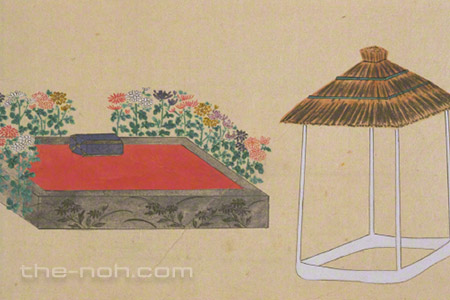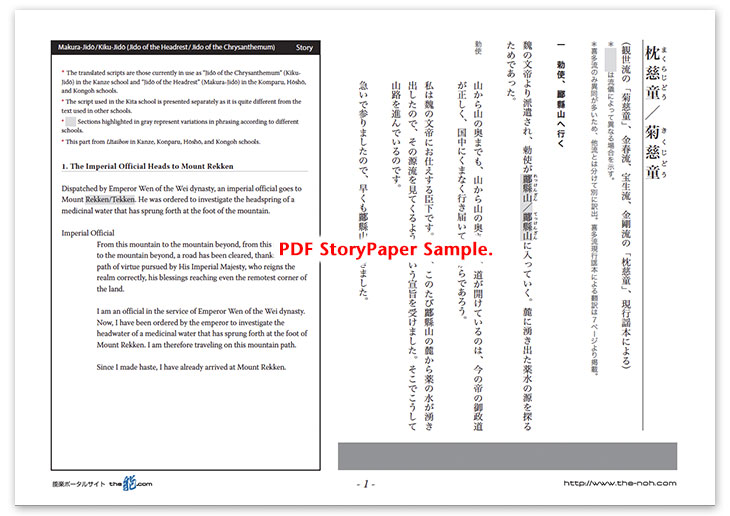
 Makura-Jidō (Jido of the Headrest)
Makura-Jidō (Jido of the Headrest)

The Kanze school calls this play, “Jidō of the Chrysanthemum” (Kiku-Jidō). They also have a play called “Jidō of the Headrest” (Makura-Jidō), but it is an entirely different piece. The Kongoh school has a similar play titled, “Peng Zu” (Hōso).”
![]()
During the era of Emperor Wen of the Wei dynasty, medicinal water sprang forth at the foot of Mount Rekken (or Tekken). Upon the emperor’s order, an imperial official is dispatched to investigate the headspring of the medicinal water. At the mountain, the official finds a hut. While he is exploring the vicinity and surveying the hut, a strange boy emerges from the hut. When the official, whose suspicions are aroused, asks the boy his name, he replies that he is Jidō and that he served Emperor Mu of the Zhou dynasty. Emperor Mu of Zhou lived more than seven hundred years ago. All the more suspicious, the official questions the boy sharply, trying to determine if he is a phantom. The boy says that he was given a headrest, upon which was the emperor inscribed two (four) verses from a sutra, and shows the headrest to the official. The official is impressed by this rare treasure and he and the boy together joyfully recite the verses of scripture. Jidō further reveals that when he copied the two (four) poetic verses onto a chrysanthemum leaf, the dew that formed on the leaf became immortal elixir and that because he keeps drinking the dew, he has lived for seven hundred years. Then, Jidō performs a dance of joy. He tells the official that dew dripping from the leaf has created a pool in the valley, which has become the headspring of the medicinal water. The official and Jidō exchange cups of the water as sake, making it an offering of prayers for the longevity of Emperor Wen and the enduring prosperity of his reign. Jidō returns to his hermit’s hut on the mountain.
![]()
This is one Noh play that describes a story set in China featuring a mysterious main character, Jidō. The legend of Jidō is described as follows in the Japanese medieval classic, The Taiheiki (Chronicle of Great Peace).
“Jidō was a boy who served Emperor Mu of the Zhou dynasty in ancient China. One day, he committed an offense by stepping over the emperor’s headrest. So severe was this offense that he barely escaped being put to death. He was driven from the court and banished to Mount Rekken. Feeling pity for the boy, Emperor Mu secretly gave him a headrest upon which he had written two verses from the Lotus Sutra and he taught him to recite these verses and pray every morning. When Jidō copied the verses onto a chrysanthemum leaf to remember them, the dew that formed on the leaf became a miraculous elixir, and the boy who drank the elixir became a hermit remaining eternally youthful for over eight hundred years. He changed his name to Peng Zu during the reign of Emperor Wen of the Wei dynasty and taught his imperial majesty the secret of longevity. The emperor, who continued to partake from the chrysanthemum cup, enjoyed ten thousand years of longevity. This is the origin of the Chrysanthemum Festival...”
The story of this Noh drama develops in a magical setting. In the middle of a deep, untrodden mountain, an imperial official in the service of Emperor Wen meets Jidō, who looks like a boy. Although this play is short, it purifies and rejuvenates the mind with its atmosphere of blissful serenity. The audience can enjoy feeling as if they have been temporarily transported away from reality to wander through a dreamlike, mystical world.
The Kanze school calls this play, “Jidō of the Chrysanthemum” (Kiku-Jidō). They also have a play called “Jidō of the Headrest” (Makura-Jidō), but it is an entirely different piece. The Kongoh school has a similar play titled, “Peng Zu” (Hōso).”
STORY PAPER : Makura-Jidō (Jido of the Headrest)
Story Paper presents noh chant stories in modern speech, with story outlines, highlights and more using Adobe PDF format, which can print out and zoom in. Print out the pages and take them with you when you see the actual noh performance.

The copyright of Story Paper is held by the Noh.com. Story Paper is for individual use only. It is prohibited by the copyright law to distribute or publish printed-out Story Paper pages without prior consent. For more information, check the credit and disclaimer pages.



 [Makura-Jidō (Jido of the Headrest) : Story Paper PDF : 478KB
[Makura-Jidō (Jido of the Headrest) : Story Paper PDF : 478KB